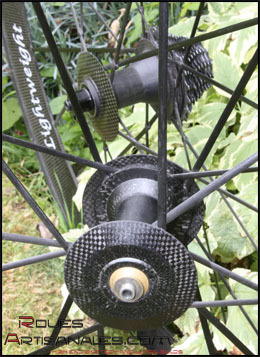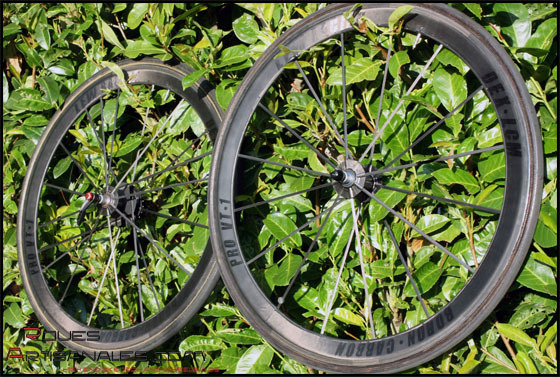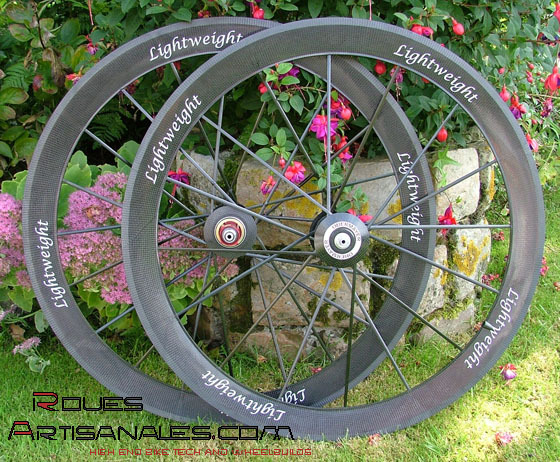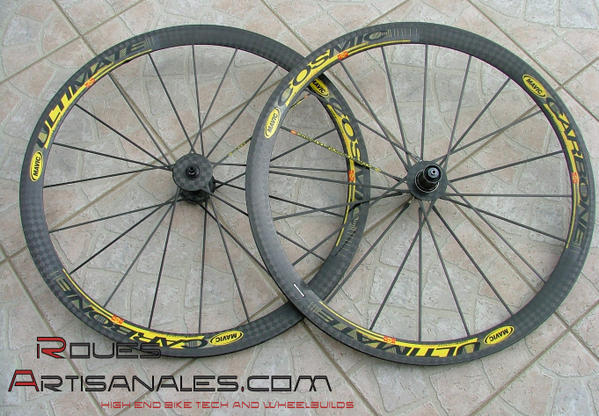|

We hadn’t been able to do intensive and long rides on the Lightweight Standard Generation 3 yet. Now it’s finally done. We got a pair in 16/20 spokes configuration to test under
all conditions and particularly in races. More important, we will compare them to the other high end wheels of the market.
Descending from Heinz Obermayer and Rudolf Dierl’s pioneering constructions, Lightweights were continued in 2003 by Erhard Wissler, head of Carbon-Sports. These generation 3 hoops benefit
from over a decade of experience and evolution: the design and manufacture really seem to have reached the limit of what’s possible and the finish is close to perfection at each level.
The perfection, yes it really is perfect! The first point which surprises when picking up a set of Lightweight generation 3s is the level of integration of every component, the dramatic
finish like fine China porclein. No screws, no traces of glue, no aesthetic default, every part is meticulously well finished. It’s clear a lot of care goes into making them.
Over the last year we had the chance to test a set of Generation 2, then Generation 3. The differences from G2 to G3 are not only the spokes and their stiffness. The wheels are far better
finished too, they are refined, elegant in some ways! And it’s worth mentioning: the Obermayer wheels have their rims miror finished (see this article). The standard version rims are mat but beautiful too.
In short, this latest evolution of the Lightweight wheels still is using the concept of the double spokes molded into the rim, and wrapped around the hub. The generation 3 features full
carbon spokes, those are stiffer than the former hybrid kevlar/carbon spokes. Carbon-Sports claims a 30% increase in rigidity. At the same time, it seems the wheels are a few grams
heavier… but after all, it doesn’t really matter. We are still speaking about a pair of wheels close to the kilogram. 1095g for the standard version, and 990g for the more expensive
Obermayer.

How do they ride?
Rigidity/Inertia
We were not ecstatic about the lateral stiffness of the Lightweight Obermayer Generation 2, mid 2007. The rim moved a lot between the brake pads, and we did not really understand why
everyone raved about their lateral stiffness.
The Standard G3 is very different. Ridden by a 65kg rider, these wheels can be compared to a shotgun: ready to go, stiff like hell, they perform superbly. OK they are about 160g heavier
than the Obermayer of our last test, but the stiffness to weight ratio is far better, and we can feel it from the first meters.
During a race, the sprints are a pleasure to perform since there does not seem to be any power loss. As long as you have the watts, the wheels will transform it into speed.
However, and we need to mention it, the wheels are so stiff that they tend to tire you even more than expected when the output is not high enough…
The « standard » are race wheels, for racers. They do not allow the lack of shape.
On the other side, the Obermayer version is nicer, the weight of the rim is at least 30g lighter, the rigidity of the rear wheel is lower and they feel easier to ride: softer and
gentler.

Aerodynamic and wind handlings

The lightweight are aerodynamic. The 53mm rim and the oval spokes make them very fast under normal conditions. We invite you to have a look at this wind tunnel test article: here.
When the wind is blowing from the side, it pushes the rim with a so high surface that the bars tends to make you change direction constantly. This is not really dangerous since the rider
gets used to it quickly and keeps a good hold of the bars.
Nevertheless, sudden gusts can be much more dangerous because the rider may not really hold the bars securely and it makes him change direction.
Alone in the countryside, it doesn’t really matter, although it’s better not to ride very close to the ditch, but in a peloton, in town with the trucks, the anxious car drivers, it is not
really safe.
These hoops are great under normal conditions but they require a lot of care when the wind blows.
In descents, we realised the Lightweight wheels tend to pull the bike to the exterior of the quick corners. It’s as if they refuse to corner and prefer to continue in a straight line.
According to some specialists, the shape of the rim, slightly curved, and very deep, is responsible for this phenomenon. In high mountains, it could slow you down.
Carbon-Sports designed in 2005 a flat rim: the ventoux, to eradicate it and significantly reduce the lateral wind sensibility. They’ve been on sale since 2006.
Comparative of the four most high-end wheels of the market
The feelings we had while riding these Lightweight Standard, in term of stiffness and inertia, were very close to the Cosmic Carbone Ultimate. However these French wheels felt one step
stiffer than the – already very stiff – Lightweight standards. Both of them are wheels for super strong/heavy guys. Basically, we would like to say that one need to be at least 70kg to get
the best out of them. Under this weight, the best solution is to go to lighter, and a little flexier, gentler wheels.
Since a few months, we have had the chance to test the four best wheels of the market, here is the comparative table. The data in this table is based on our qualitative impressions riding
on the road as well as laboratory testing.
The marks are given on a scale of 5. Higher is the mark, better is the performance.
The scale of marks takes into account every wheels of the current market.
|
Criterions
|
Lew Racing Pro VT-1
|
Lightweight Obermayer Génération 3
|
Lightweight Standard Génération 3
|
Mavic Cosmic Carbone Ultimate
|
|
Weight
|
5+
|
5
|
4
|
4
|
|
Rotationnal inertia
|
5+
|
5
|
4
|
4
|
Lateral stiffness
Front/rear
|
2/1
NB: the central flange transfers all the power and « prevents » the rim from moving between the brake pads
|
5+/3
|
5+/5
|
5/5+
NB: The rear wheel lateral stiffness reaches an outstanding value: 59N/mm under a 20kg load!
|
|
Aerodynamic
|
4
|
4
|
4
|
4
|
|
Crosswinds sensivity
|
3
|
1
|
1
|
3
|
|
Finish
|
2
|
5
|
5
|
3
|
Bearing fluidity
Front/rear
|
5/5
|
5/3
|
4/4
|
4/4
|
Braking performance under dry circumstances
Appropriated brake pads
|
5
Smooth and very strong braking
|
4
Excellent braking, rough/granular braking surface
|
4
Excellent braking, rough/granular braking surface
|
4
Excellent and smooth braking (smooth braking track)
|
Braking performance under wet circumstances
Appropriated brake pads
|
4
Very progressive, the water layer disappear after a couple of wheel rotation
|
2
No power during the few first wheel rotation, the water layer needs some time to disappear
|
2
No power during the few first wheel rotation, the water layer needs some time to disappea
|
2
No power the first during a few wheel rotation, the water layer needs some time to disappear
|
|
Price
|
1
|
1
|
2
|
2
|
|
Weight limit
|
90kg
|
110kg
|
110kg
|
100kg
|
|
Reparation
|
Every parts can be repaired
|
Possible only in case of small impact on the rim
|
Possible only in case of small impact on the rim
|
Impossible, but MP3 program
|
|
Picture
|

|

|

|

|
|







